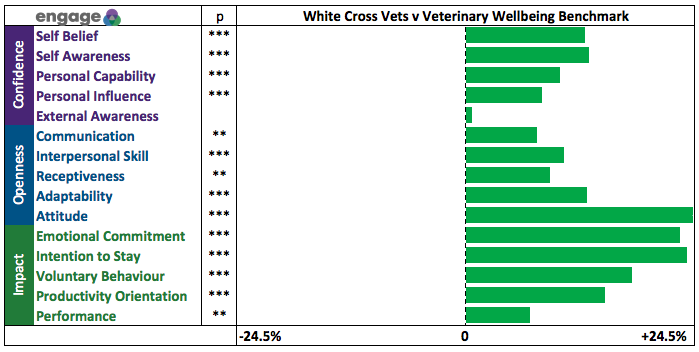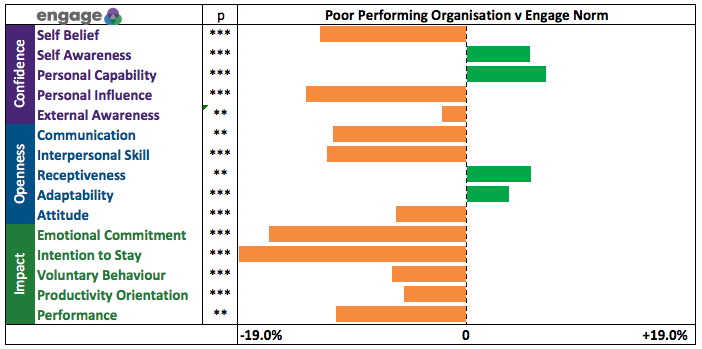Leadership is always key. Bob ran a team within an insurance company. His results were average, and the level of engagement within the team was also average. Conversely, Sheila worked in the same company, yet levels of engagement and results were off the chart. What was the difference?
Leadership Engagement
Sheila’s team were motivated, confident to do their jobs and open to learning and new ways of doing things. As a consequence, results were far superior to Bob’s. A good leader will have a highly engaged team. A simple definition of engagement is “I bring my all”. But how can we measure the impact of leadership on engagement?
Engage provides a unique perspective on engagement by focussing on employee mindset. From your own experience you will know that your own mindset changes dependant on your context. First day on a job you may feel less confident, and if you have a bullying boss you will feel less motivated. Engage assesses perceived levels of confidence, openness and impact within the current context.
Confidence
Confidence plays a key role in engagement. Do I feel confident to do my job? Can I influence others such as my boss, colleagues or outcomes? Am I aware of myself, and my impact on others? Do I feel I can take risks, make decisions and carry through with resilience? Does my boss believe in me? Are they aware of what is going on for me and give me positive support and opportunity to prove myself?
Openness
Is my manager open with me, ensuring clarity in conversations and objectives? Does my work environment care about me, and allow me to build meaningful relationships? Are we open to change, and to feedback, and willing to try new ways of doing things? Are we more optimistic than cynical?
Impact
Is there clarity around objectives? Do leadership walk the talk? Do the values and objectives of the company match my own? Am I empowered to make decisions and do I have the resources I need to do my job? If so, I’m more likely to really “bring my all” and go the extra mile, be committed and feel a strong sense of attachment. I’m more likely to be driven to achieve, and as a result feel that I am successful in my role.
The Data Does Not Lie
We have assessed engagement across a large number of groups from a wide range of sectors, and the data does not lie. We can predict which teams are generating superior results, and those who are not. We can also specify where organisations should focus attention to increase engagement and drive superior results.
What does poor look like?
Where organisations struggle with engagement, employees feel less confident, less able to positively influence outcomes and feel less motivated and committed. The result is higher staff turnover, and poor outcomes.
Here is the “collective mindset” data from one organisation (which shall remain nameless!) experiencing significant retention issues. There are a number of significant scores lower than the norm, suggesting a a culture ruled by “do as I say”. Poor communication, with little care for employees, suggests a transactional environment, with focus on numbers rather than people. Maybe you’ve worked in similar (or are right now)?
When working with this organisation we started with the leadership team. What are the challenges being faced? How does the senior leadership team score? How do personal and team scores influence the culture reflected in the above chart? What is required (individually and as a team) to positively impact engagement?
What does good look like?
The veterinary world, like many other sectors, is undergoing huge change. Independent practices are being purchased by corporates (increased from 20 to 50% of the market in 2 years). Vets are four more times likely to commit suicide, and staff churn is often in excess of 30% per annum.
Against this backdrop is White Cross Vets, a veterinary company with 19 practices and over 200 staff across the UK. They buck the trend. They experience industry busting retention figures, they are acquiring new practices by reinvesting profits and they win every award going as a great place to work.
We used Engage to assess their employees. Greens shows a positive difference compared to our norm group, orange shows a negative difference. Here is their data;

Scores such as these suggest an engaged, visionary, empowering senior leadership team who care about their staff. The result is a highly engaged workforce.
What culture is your leadership driving?
Engagement starts with good leadership. Sheila was a good leader.
By assessing yourself, and/or your senior team, and reviewing the data in light of your key challenge or objective, we are able to quickly identify what is helping, or hindering you from reaching your objectives. We offer coaching, workshops and development programmes to help understand the data, and identify key actions which address the issues. For a confidential conversation please get in touch.
Mark Bateman is the CEO of Engage Coach International and an Executive/Leadership Coach. He is a successful entrepreneur, has a Masters in Leadership Coaching and has worked with hundreds of leadership teams.
Want to speak to us about your challenges? Contact Mark for a confidential conversation.



